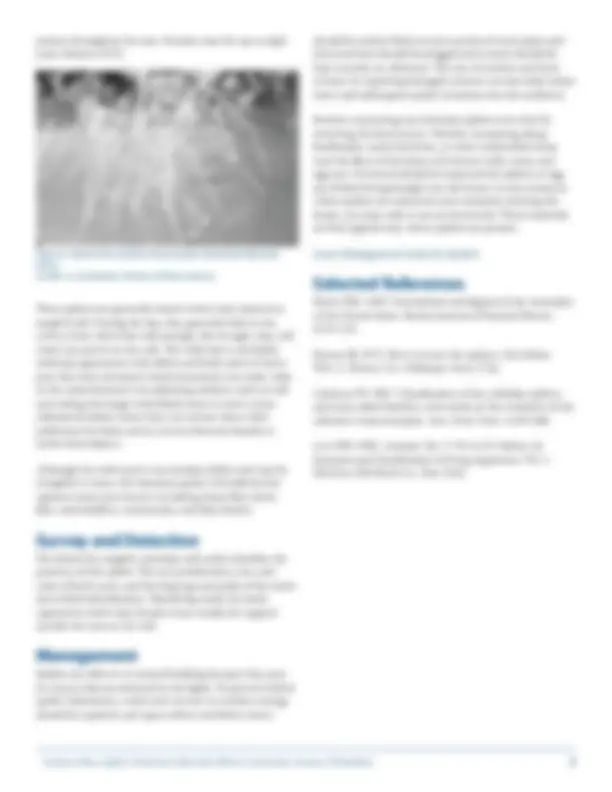



Study with the several resources on Docsity

Earn points by helping other students or get them with a premium plan


Prepare for your exams
Study with the several resources on Docsity

Earn points to download
Earn points by helping other students or get them with a premium plan
Community
Ask the community for help and clear up your study doubts
Discover the best universities in your country according to Docsity users
Free resources
Download our free guides on studying techniques, anxiety management strategies, and thesis advice from Docsity tutors
Information about the southern house spider (kukulcania hibernalis), including its identification, description, habits, habitats, and management. The document also includes figures and credits for the images used. The southern house spider is a common arachnid in florida and the southern united states, known for its large size and distinctive flat, tangled web. It is not dangerous to humans, but some people may experience pain and swelling after being bitten. The document also discusses the spider's systematics, including its classification and relationship to other spiders.
Typology: Lecture notes
1 / 3

This page cannot be seen from the preview
Don't miss anything!


EENY
The southern house spider (Figures 1–5), Kukulcania hibernalis (Hentz 1842), is a conspicuous arachnid in Florida due to its relatively large size and distinctive flat, tangled web. It is common throughout Florida and much of the southern United States in human populated areas. As a group, filistatid spiders are known as crevice spiders, and this species is sometimes referred to as the southern crevice spider. Males of this species are often mistaken for the notorious brown recluse spider, Loxosceles reclusa Gertsch and Mulaik, because of their color and general shape. Southern house spiders are not known to have a dangerous bite. However, two bite cases reportedly caused the victims pain and swelling for up to two days.
The southern house spider was described in the genus Filistata, but was later placed in the genus Kukulcania (Lehtinen 1967). The Filistatidae are related to a group of primitive Araneomorphae that collectively are known as Haplogynae. This group includes other spiders sometimes prone to occur in houses, such as the cellar spiders (Pholci- dae), spitting spiders (Scytodidae), and the brown recluses and relatives (Sicariidae). Figure 1. Southern house spider, Kukulcania hibernalis Hentz. Credits:Edward L. Manigault, Clemson University; www.insectimages. org Figure 2. Lateral view of female southern house spider, Kukulcania hibernalis Hentz. Credits: G. B. Edwards, Division of Plant Industry
Southern House Spider, Kukulcania hibernalis (Hentz) (Arachnida: Araneae: Filistatidae) 2 Description Kukulcania hibernalis is a species that exhibits a great degree of sexual dimorphism. Females are charcoal gray and 13–19 mm in length. Females often have dusky patches on the carapace. The abdomen is elongate-ovoid, and at times can be considerably distended, e.g., after feeding or if the female is gravid. The male spider is 9-10 mm in length, khaki to amber in color and has long slender legs and palpi (the distal segments of the latter fold back along the proxi- mal segments). Males also have a brown stripe from behind the eye prominence, which narrows quickly to include only the thoracic groove. The violin mark of the brown recluse is conspicuously wider and continues to the posterior edge of the carapace. Also, male K. hibernalis are generally larger than L. reclusa, have much longer legs and palpi, and have eight eyes grouped together on a raised prominence, rather than the six eyes in three pairs possessed by L. reclusa. Spiders in the family Filistatidae have structures called a cribellum (a silk-producing plate found anterior to the spinnerets) and a calamistrum (a row of specialized setae on the 4th metatarsus used for pulling silk from the cribel- lum). The silk has properties similar to velcro, in that it readily adheres to projections on other arthropods such as claws, setae, spines, and textured integument. When spun into sheets, it is an effective trap for insect prey. The male has these structures reduced or absent, as it does make a web in the adult stage. Habits and Habitats The southern house spider is partial to spaces within the masonry of buildings, especially dark recesses of windowsills, shutters and overhangs. Females and juveniles make specialized webs (Figure 6) that are occasionally found under tree bark but are frequently seen on houses, barns, bridges, and other man-made structures. Here a spider seeks out a sheltered crevice for a nest, around which a distinctive web is made on the adjoining substrate. Under microscopic inspection, the silk of this web appears to be “woolly,” an appearance created by the action of the calamistrum pulling silk from the cribellum. This web lacks sticky droplets which are characteristic of entrapment strands in webs of some other spider families. Rather, with K. hibernalis, the structure of the web itself is responsible for entangling prey. Males do not build webs but instead wander in search of females in order to mate. Females lay about 200 eggs that are loosely swathed in a silken ball about 15 mm in diameter and are kept with the female in her nest. In Florida, all stages of development seem to be Figure 3. Lateral view of male southern house spider, Kukulcania hibernalis Hentz, showing elongated palpi (arrow). Credits: G. B. Edwards, Division of Plant Industry Figure 4. Dorsal view of male southern house spider, Kukulcania hibernalis Hentz. Credits: Jeffrey Lotz, Division of Plant Industry Figure 5. Female brown recluse spider, Loxosceles reclusa Gertsch and Mulaik, dorsal view for comparison with dorsal view of male southern house spider, Kukulcania hibernalis Hentz. Credits: Jeffrey Lotz, Division of Plant Industry